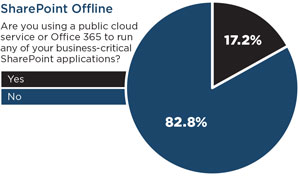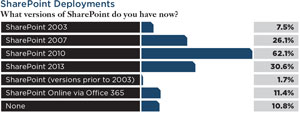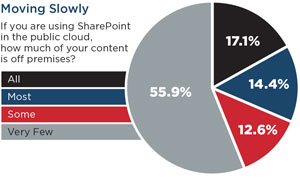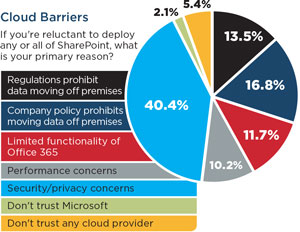In-Depth
Dark Clouds: SharePoint Online Concerns Slowing IT Adoption
Microsoft says SharePoint customers are moving online but security, privacy and app compatibility are key barriers. A Redmond magazine reader survey suggests the transition will take time. Find out why.
As Microsoft's SharePoint continues its fast-track transition to the cloud, the most widely used collaboration, document management and information sharing platform is going through a rough patch these days. While Microsoft is pleased with the number of customers embracing SharePoint Online in Office 365, as well as those starting to deploy SharePoint server instances in the new Windows Azure Infrastructure Services, a large number of enterprises of all sizes are uncertain when or if they will make the move to the cloud.
This year's release of Office 365 SharePoint Online coincided with Microsoft shipping SharePoint 2013. It also shares a new app model and key properties, including support for SkyDrive Pro. They don't have all the same features, though. (This TechNet article provides a comparison: http://tinyurl.com/cpwarfa).
Microsoft hasn't revealed how many customers have the latest server or are subscribing to SharePoint Online, but it's intent on closing the gap between the cloud and server versions. A survey of nearly 500 Redmond magazine readers conducted last month shows 30.6 percent already have at least one SharePoint 2013 on site and 13.5 percent say the new release is now the most prevalent version. The most widely deployed is SharePoint 2010, which 62.1 percent have in some form and 57.2 percent describe as most pervasive.
When it comes to the cloud, though, only 17 percent now run a SharePoint service online, while only 8 percent describe Office 365 as their primary SharePoint implementation. For all the talk about SharePoint's transition to the cloud, an overwhelming majority --83 percent -are still running their SharePoint platforms on-premises. Only a small percentage of those running SharePoint in-house only have short-term plans to do so. Within the next 6-12 months, 18 percent will run SharePoint online and 8 percent within two years.
Time for a Reboot?
A chorus of experts wonder what the future holds for SharePoint and whether it will maintain its stature as the leading platform for collaboration and documents/content management. It also remains to be seen if it can successfully evolve to embrace enterprise social networking, search and business intelligence.
A session at Gartner Inc.'s annual Symposium/ITxpo conference in October sensationally called "Should Microsoft Kill SharePoint?" elevated those questions. Analyst Jeffrey Mann, who led the session, said SharePoint isn't going away, but he emphasized it's going through profound architectural changes and new usage models.
 [Click on image for larger view.]
A vast majority have yet to run any of their SharePoint content in the public cloud.
[Click on image for larger view.]
A vast majority have yet to run any of their SharePoint content in the public cloud.
"It's time for a reboot," Mann told the audience of CIOs. "Microsoft has been very clear that the future of SharePoint and pretty much the entire company, and in many ways the entire industry, is in the cloud. So they're putting a great deal of emphasis on cloud deployment. So what does that mean for the 95 percent of users that are still on-premises? Microsoft is already beginning to lay the foundations for a post-SharePoint world, or at least a SharePoint which is very different."
It's likely the SharePoint community will get a better sense of how different that will be in March when Microsoft holds its SharePoint conference in Las Vegas. That event has been held in the fall in recent years, but was pushed off last year. Microsoft has clearly signaled all of its key products will only go deeper into the cloud. When it comes to SharePoint, integrating it with Yammer, the cloud-based enterprise social networking service Microsoft acquired last year for $1.2 billion, will be a key component of that.
Mann does predict, and most would agree, the Yammer activity stream will replace the new SharePoint news feed introduced in the current release. The improved news feed was a major feature Microsoft trumpeted with SharePoint 2013 prior to the Yammer acquisition (see "Configuring and Using SharePoint 2013 for a Social Enterprise," July 2013). "They're going to be putting their effort into drawing you more into Yammer," Mann said.
 [Click on image for larger view.]
Nearly two-thirds say they're using Microsoft's Office 365, while a small fraction are using other options such as Windows Azure, third-party cloud providers or colocation facilities. SharePoint deployments on Windows Azure are poised to rise in the future.
[Click on image for larger view.]
Nearly two-thirds say they're using Microsoft's Office 365, while a small fraction are using other options such as Windows Azure, third-party cloud providers or colocation facilities. SharePoint deployments on Windows Azure are poised to rise in the future.
SharePoint's Enterprise Success
SharePoint usage is growing, though, in varying degrees. A survey by the Association for Information and Image Management (AIIM) of its membership found 57 percent use SharePoint and 31 percent say it's their primary document and content management system. Of those, 40 percent reported their implementations were moving forward, 33 percent were struggling, 28 percent said progress has stalled and only 6 percent describe it as a great success.
"We are definitely seeing rising frustration, but it's not the fault of the product. I think it's the fault of the people who were buying this and implementing it, who didn't quite think through the question of whether they were actually buying a platform rather than an application," says John Mancini, AIIM's president. "We've seen that rising concern about extending the business scope, about governance, all that stuff. But I'd say by and large a fair amount of that is the by-product of the haphazard way most people implemented it,"
The indiscriminant approach might make transitioning to the cloud more complicated. The reasons many are reluctant to use SharePoint Online point to other factors. Not surprisingly, the largest reasons by far were security and privacy concerns, cited by 40.4 percent of survey respondents. The next greatest concerns were company policies prohibiting the movement of data off premises (16.8 percent), regulatory restrictions (13.5 percent) and limited functionality in Office 365 (11.7 percent).
The topic of Office 365 SharePoint Online's limitations is controversial in part because of the new Software as a Service (SaaS)-based application development model. Microsoft and proponents of this model see it as taking SharePoint into the modern apps cloud era. Critics say while that's fine, it can't run applications built for earlier versions of SharePoint.
 [Click on image for larger view.]
SharePoint 2010 is the most widely deployed, but less than a year after its elease, nearly one-third say they have already rolled out SharePoint 2013.
[Click on image for larger view.]
SharePoint 2010 is the most widely deployed, but less than a year after its elease, nearly one-third say they have already rolled out SharePoint 2013.
Our survey findings are consistent with other reports, such as one prepared by Forrester Research Inc. in October. That report found only 15 percent of respondents were using Office 365 SharePoint Online, up just 3 percent over last year, prior to the release of the enhanced service.
Forrester analyst Rob Koplowitz believes SharePoint users will ultimately move the collaboration platform online, but the transition will take many years. "I think it will take a long time to get all of these on-premise users to the cloud," Koplowitz says. "But Microsoft is nothing but patient and I do think that really the cloud offers them development opportunities that are substantially more interesting than on-premises."
A small minority, 17 percent of Redmond readers, say they will never run SharePoint off site, which isn't surprising considering some businesses with governance limitations or applications have requirements that would make running it in the cloud untenable. More telling, though, is that 58 percent don't know when they will use SharePoint Online. While that may suggest a lack of urgency in addressing the issue, many, including Microsoft and a number of SharePoint partners and consultants, are seeing stronger uptake and interest than the data suggests.
For example, while 28 percent in Forrester's survey say SharePoint in the cloud was never a consideration, that's actually an improvement. Last year, that figure was 38 percent. "I would say never is a long time," Koplowitz says. "But that being said, there are some organizations that right now cannot themselves -- either due to security, privacy or regulatory issues -- see it happen. And there's a bunch of others who have really highly customized instances of SharePoint which doesn't translate well to the cloud because they have deep integration and data sovereignty issues."
Do Numbers Explain Everything?
Respondents saying they don't or won't use SharePoint in the cloud may not be telling the entire story, several experts said. "I'm not sure we're seeing `real' and reliable adoption numbers," says Dan Holme, a well-regarded SharePoint MVP and principal with Intelliem Inc., which works with numerous large enterprises. "There are a number of people I've met, personally, who don't actually know that they're using SharePoint Online."
It's not feasible for most large organizations to move everything haphazardly to the cloud, observers say. That being the case, hybrid implementations will be a way of life for many years to come. "It's going to be a hybrid world for the near term, and customers and Microsoft both need to adjust to that reality," Holme says.
Hybrid Cloud Architectures
Numerous consultants and ISVs say they're seeing customers start to use SharePoint Online, especially those who don't have the budgets or internal resources to develop and deploy it on premises. Analysts say SharePoint is widely deployed across a broad spectrum of enterprises and public-sector organizations. CTOs and enterprise architects are looking at moving to the cloud incrementally and with a hybrid architecture.
 [Click on image for larger view.]
Most that are using SharePoint in the cloud are running few or some applications online.
[Click on image for larger view.]
Most that are using SharePoint in the cloud are running few or some applications online.
"We are seeing more hybrid deployments now with organizations utilizing SharePoint on-premises, but [with] SkyDrive Proor going a step further and putting externally facing site collections and data into SharePoint Online while private remains on-premises," says Loryan Strant, an Office 365 MVP with Paradyne Cloud Consulting in Australia, a Microsoft Office 365 partner.
"Customers want to move to SharePoint 2013, on premises, and they want that on-premises container to be the central integration point, to pull down selected services from the cloud," adds Chris McNulty, CTO-SharePoint at Dell Inc.'s software group. "So if they have some external collaboration sites they want to put with Office 365, they want on-premises to be the central discovery point, the search engine that reaches out to those."
Enterprises that do have plans to run SharePoint in the cloud are leaning toward using Office 365, our survey found. While 66 percent of current SharePoint online users have Office 365 subscriptions, 14 percent are using Windows Azure and 15 percent are using other cloud providers. Of those planning to run SharePoint in the cloud in the future, 55 percent will opt for Office 365 and nearly 29 percent will use Windows Azure.
 [Click on image for larger view.]
Not surprisingly, security and privacy was the most common reason respondents said they're reluctant to use SharePoint in the public cloud.
[Click on image for larger view.]
Not surprisingly, security and privacy was the most common reason respondents said they're reluctant to use SharePoint in the public cloud.
Overcoming App Compatibility Limitations
The rising number of those planning to run SharePoint in Windows Azure can be attributed to the fact that Microsoft only made it possible this year when adding infrastructure as a service (IaaS) VM hosting. The surprisingly growing move toward Windows Azure also points to a segment of SharePoint shops that are turned off by the lack of code portability from older versions of SharePoint. By standing up their own SharePoint servers in Windows Azure, they get the benefit of running their custom or shrink-wrapped apps in the cloud.
"People don't do customization of SharePoint Online using the old method because the product limits what they can do," explains Forrester analyst John Rymer. "Integration, for example, is pretty limited, and Microsoft will not accept just any random code."
Whether or not Office 365 is a real deal-breaker depends on the customer's application and overall requirements. "If you want to use all of the content management capabilities, deeper integration into other line of business systems, those are the kinds of customers that will continue to run SharePoint either in their own servers or Windows Azure," says Adriaan Van Wyk, CEO of K2, a provider of a SharePoint workflow app for Office 365 that uses Windows Azure.
John Hodges, VP of global account product management at longtime SharePoint ISV AvePoint Inc. feels the new cloud app model gives organizations more flexibility. "We've seen a few of our more advanced customers jump right into this model and say `this is great, we're now going be hosting an app on Windows Azure that's going to be working to service specific business groups'needs and that's going to be surfaced through their Team Site but it doesn't have to be running on my SharePoint service.' It gives the developers much more independence."
Ultimately a must-have app will drive SharePoint Online, Holme predicts. "What's going to happen, as time passes, is that there will be high-value solutions available that a business customer will want, and want it `now,' and the internal SharePoint implementation won't be able to deliver it, so that customer will be better served with a site in Office 365 which fully supports the app model," Holme says.
Also making SharePoint Online compelling is SkyDrive Pro's 100 GB storage per site collection and 10,000 external licenses, Strant says.
While smaller organizations are the most obvious candidates to go to SharePoint Online Office 365, especially if they don't have a collaboration solution, larger shops have more complicated decisions to make. Whether or not larger shops are using Office 365, Windows Azure or third party infrastructure as a service (IaaS) or managed services providers (or any combination of those), it's clear most will deploy hybrid implementations. They'll adding capacity to existing SharePoint infrastructure incrementally.
Most are hopeful the path to overcoming existing obstacles will become clearer at Microsoft's SharePoint conference in March, when the company is expected to outline its future roadmap. "There are still dark clouds in SharePoint," Dell's McNulty says, "but I would say they seem to be lifting."